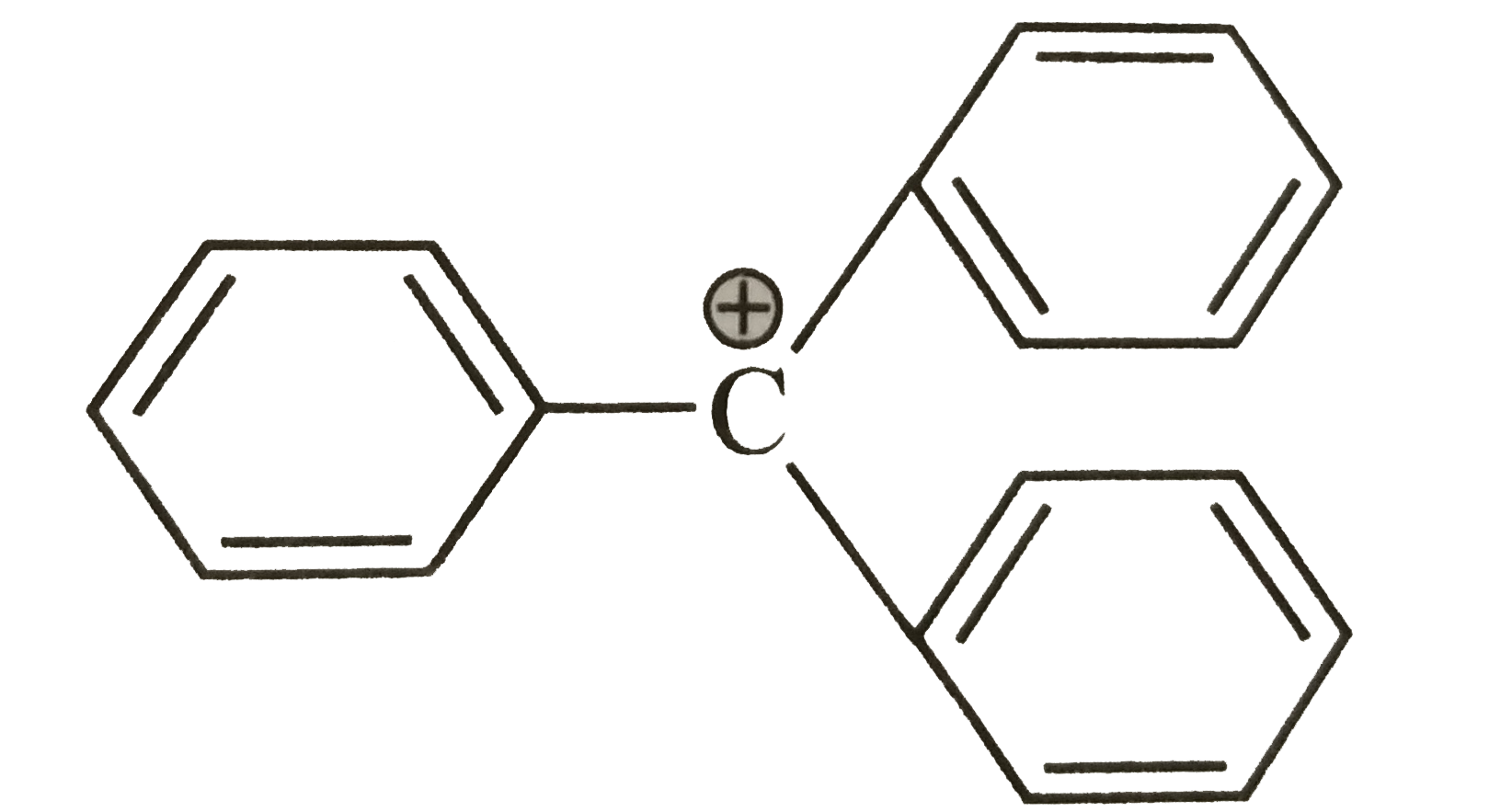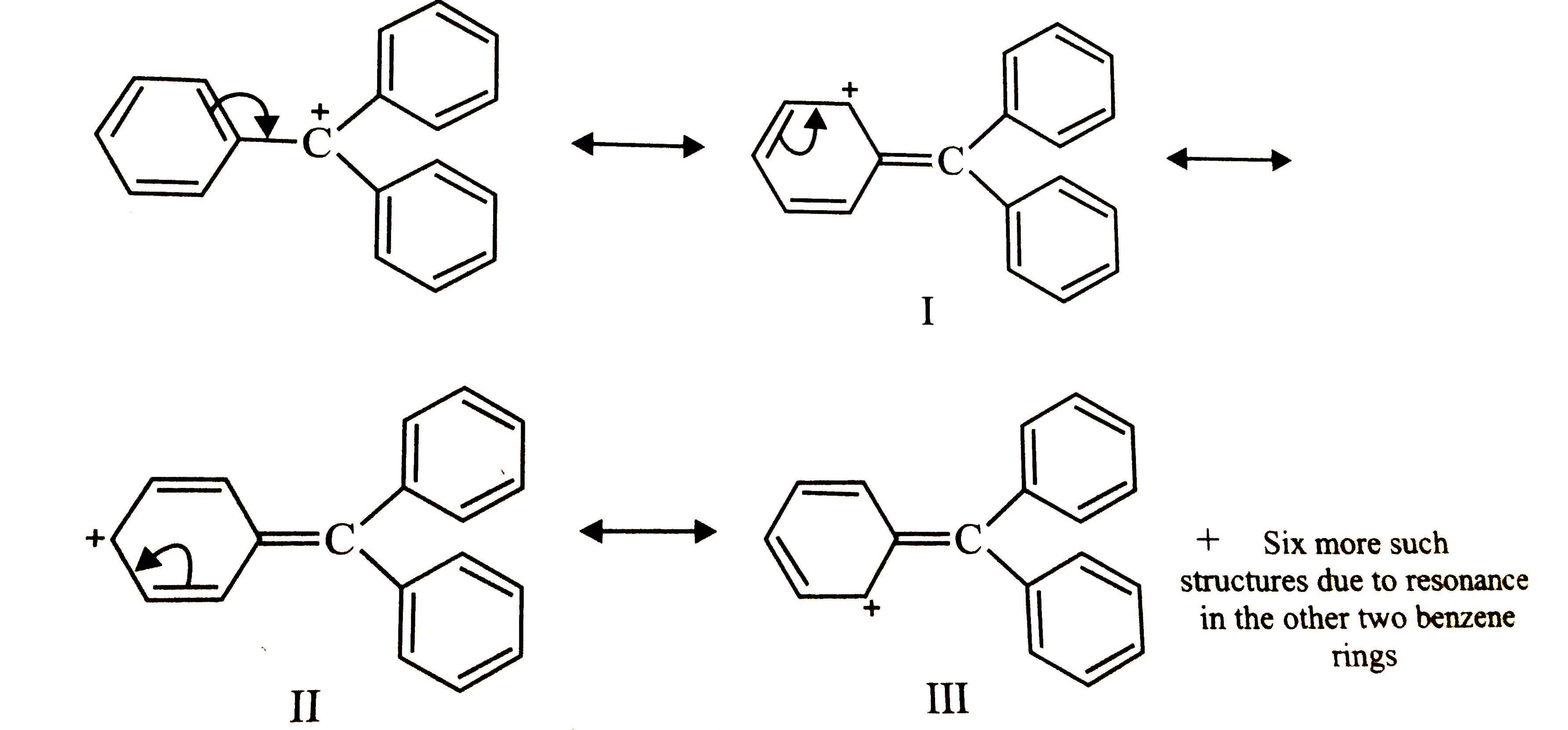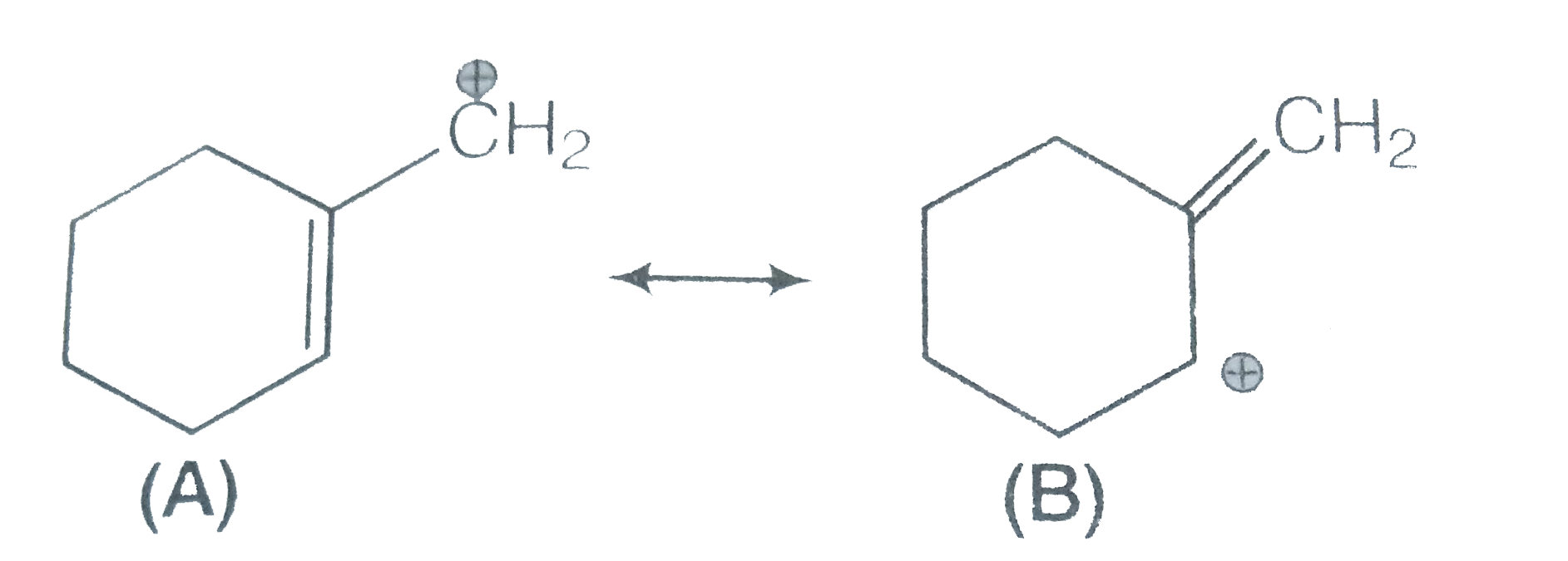"Stability of carbocation depends upon the electron releasing inductive effect of groups adjacent to positively charged carbon atom, involvement of neighbouring groups in hyperconjugation and resonance".
The structure of triphenylmethyl cation is given below. This is very stable and some of its salts can be stored for months. Explain the cause of high stability of this cation.

Due to resonancce, the +ve charge can move at both the o-and one p-position of each benzene ring. As a result, three resonance structures (I, II and III) are possible for each benzene ring as shown below. Since there are three benzene rings, therefore, there are, in all, nine resonance structures. Thus, triphenylmethyl cation is highly stable due to these nine resonance structures.

Topper's Solved these Questions
- ORGANIC CHEMISTRY-SOME BASIC PRINCIPLES TECHNIQUESBOOK - PRADEEPCHAPTER - ORGANIC CHEMISTRY-SOME BASIC PRINCIPLES TECHNIQUESEXERCISE - NCERT EXEMPLAR PROBLEMS WITH ANSWERS, HINTS AND SOLUTIONS (Matching Type Questions)
3 Videos
- ORGANIC CHEMISTRY-SOME BASIC PRINCIPLES TECHNIQUESBOOK - PRADEEPCHAPTER - ORGANIC CHEMISTRY-SOME BASIC PRINCIPLES TECHNIQUESEXERCISE - NCERT EXEMPLAR PROBLEMS WITH ANSWERS, HINTS AND SOLUTIONS (Assertion and Reason Type Questions)
6 Videos
- ORGANIC CHEMISTRY-SOME BASIC PRINCIPLES TECHNIQUESBOOK - PRADEEPCHAPTER - ORGANIC CHEMISTRY-SOME BASIC PRINCIPLES TECHNIQUESEXERCISE - NCERT EXEMPLAR PROBLEMS WITH ANSWERS, HINTS AND SOLUTIONS (Multiple Choice Questions - II)
7 Videos
- HYDROGEN BOOK - PRADEEPCHAPTER - HYDROGEN EXERCISE - COMPETITION FOCUS (Assertion-Reason Type Questions) Type 2
15 Videos
- P-BLOCK ELEMENTS (NITROGEN FAMILY)BOOK - PRADEEPCHAPTER - P-BLOCK ELEMENTS (NITROGEN FAMILY)EXERCISE - Competition focus jee(main and advanced)/ medical entrance special) (VIII. Assertion-Reason Type Questions)
10 Videos
Similar Questions
'Stability of carbocations depends upon the electron releasing inductive effect of groups adjacent to positively charged atom involvement of neighbouring groups in hyperconjugation and resonace''.
The structure of triphenylmethyl cation is given below. This is very stable and some of its salts can be stored for months. Explain the cause of high stability of this cation

View Solution"Stability of carbocations depends upon the electron releasing inductive effect of groups adjacent to positively charged carbon atom involvement of neighbouring groups in hyperconjugation and resonance."
Which of the following ions is more stable ? Use reasonance to explain your answer.

View Solution
Knowledge Check
The electronic displacements in covalent bonds may occur either in the ground state under the influence of an atom or a substituent group or in presence of an appropriate attacking reagent. As a result of these electron displacements, centres of different electron densities are created and these centres are susceptible to attack by the reagents. These electron displacements occur through inductive electromeric, resonance and hyperconjugation effects. Whereas inductive effect involves displacement of σ-electrons towards the substituent, resonance effect involves delocalization of π−electrons transmitted through the chain and both are permanent effect. Electromeric effect is the complete transfer of a shared pair of π- electrons to one of the atoms joined by a multiple bond on the demand of an attacking reagent. Hyperconjugation effects on the other hand involve delocalization of σ-electrons of C−H bond of an alkyl group directly attached to an atom of unsaturated system (i.e., σ−π-conjugation). Both inductive and hyperconjugation effects can be used to explain the stability of carbocations and free radicals which follow the stability order : 3∘>2∘>1∘. The stability or carbanions, however, follows the reverse order.
An organic reaction occurs through making and breaking of bonds. The breaking of a covalent bond may occur either homolytic leading to the formation of free radicals or heterolytic forming positively (carbocations) or negatively (carbanions) charged species. Most of the attacking reagents carry either a positive or a negative charge. The positively charged species with electron deficient centre or neutral species (free radicals, carbenes, nitrene) are collectively called electrophiles, while negatively charged species with electron rich centre or neutral species (like water, alcohol, ammonia, etc.) are called nucleophiles.
Which of the following is most stable cation?AF3C−CH+2B(CH3)2CH+CCH+3DCF−3
'Stability of carbocations depends upon the electron releasing inductive effect of groups adjacent to positively charged atom involvement of neighbouring groups in hyperconjugation and resonace''.
Which of the following ions is more stable ? Use resonance of explain your answer.

View Solution'Stability of carbocations depends upon the electron releasing inductive effect of groups adjacent to positively charged atom involvement of neighbouring groups in hyperconjugation and resonace''.
Write structure of various carbocations that can be obtained from 2-methylbutane. Arrange these carbocations in order of increasing stability
View Solution'Stability of carbocations depends upon the electron releasing inductive effect of groups adjacent to positively charged atom involvement of neighbouring groups in hyperconjugation and resonace''.
Write structure of various carbocations that can be obtained from 2-methylbutane. Arrange these carbocations in order of increasing stability
View Solution'Stability of carbocations depends upon the electron releasing inductive effect of groups adjacent to positively charged atom involvement of neighbouring groups in hyperconjugation and resonace''.
Write structure of various carbocations that can be obtained from 2-methylbutane. Arrange these carbocations in order of increasing stability
View Solution'Stability of carbocations depends upon the electron releasing inductive effect of groups adjacent to positively charged atom involvement of neighbouring groups in hyperconjugation and resonace''.
Draw the possible resonance structures for CH3−..O..−+CH2 and predict which of the structures is more stable. Give reason for your answer.
View Solution'Stability of carbocations depends upon the electron releasing inductive effect of groups adjacent to positively charged atom involvement of neighbouring groups in hyperconjugation and resonace''.
Draw the possible resonance structures for CH3−..O..−+CH2 and predict which of the structures is more stable. Give reason for your answer.
View Solution'Stability of carbocations depends upon the electron releasing inductive effect of groups adjacent to positively charged atom involvement of neighbouring groups in hyperconjugation and resonace''.
Draw the possible resonance structures for CH3−..O..−+CH2 and predict which of the structures is more stable. Give reason for your answer.
View Solution
